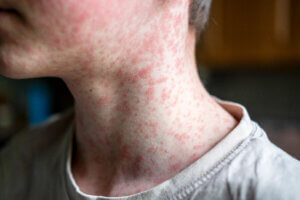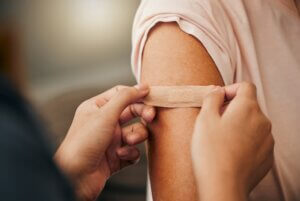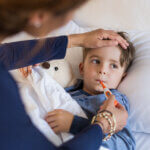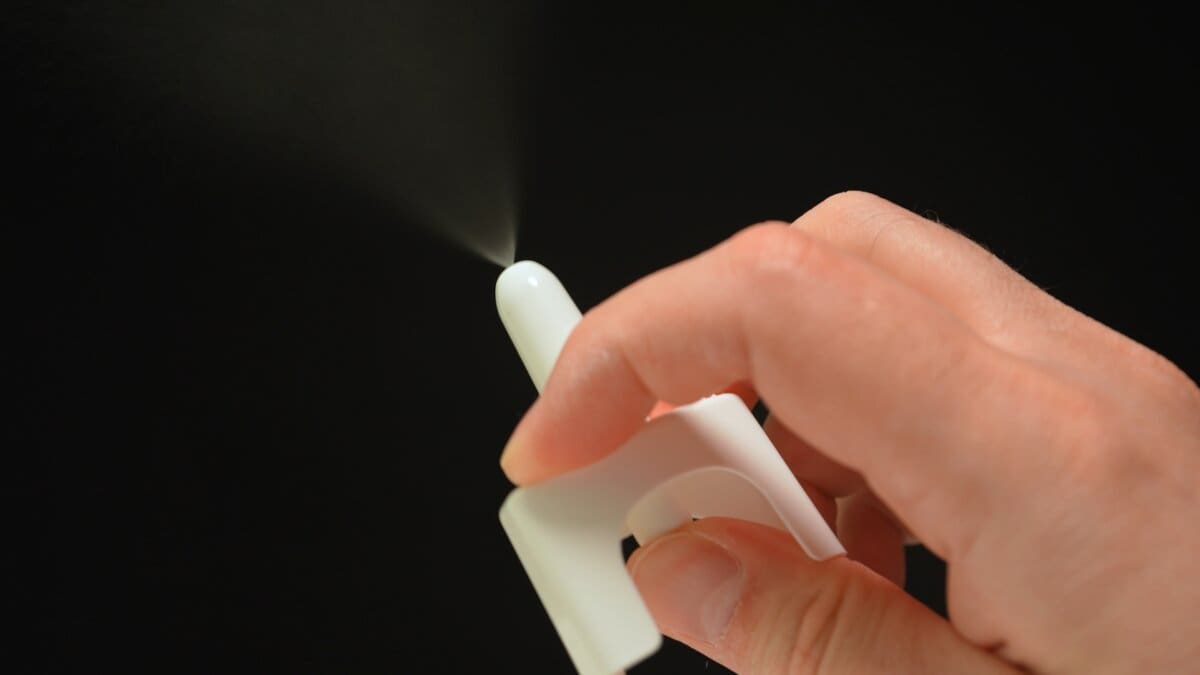Healthy Family
Measles 101: Know the Signs, Know the Facts
While measles has long been controlled by mass vaccination, recent outbreaks of the virus—also known as rubeola—remind us that understanding and being able to recognize and help prevent the spread of the disease is essential to public health. Here’s what you need to know.
What is Measles?
The scientific name for measles is Morbillivirus within the Paramyxoviridae family. It is a single-stranded, enveloped RNA virus. This childhood disease differs from other childhood illnesses due to how highly contagious it is as well as the unique, blotchy rash it causes.
Throughout history and prior to the introduction of a vaccine for the disease in 1963, measles had a grave impact on childhood populations across the globe. According to the World Health Organization, “Major measles epidemics occurred approximately every two to three years and caused an estimated 2.6 million deaths each year.” The organization notes immunization efforts prevented an estimated 60 million deaths between 2000–2023, decreasing measles deaths from 800,062 in 2000 to 107,500 in 2022, globally.
How Measles Spreads
Measles is so dangerous in large part because of how contagious it is. The virus spreads through airborne respiratory droplets, such as from coughing, sneezing or simply talking to another person. It can also survive on surfaces, such as tables, chairs and desktops. People can become infected by touching one of these surfaces and then touching their face.
People can be contagious beginning four days before the measles rash appears and lasting four days after the rash has appeared. Many consider measles to be one of the most contagious diseases known, with about 9 out of 10 susceptible individuals becoming infected through exposure, or a secondary attack rate of approximately 90%. Conversely, according to the Centers for Disease Control, “When more than 95% of people in a community are vaccinated, most people are protected through community immunity (herd immunity).”
Signs and Symptoms
 The early signs of measles are similar to a variety of other childhood illnesses and include: fever that can reach upwards of 105 degrees Fahrenheit, or 40.6 degrees Celsius, runny nose, watery, goopy eyes (conjunctivitis) and a dry cough.
The early signs of measles are similar to a variety of other childhood illnesses and include: fever that can reach upwards of 105 degrees Fahrenheit, or 40.6 degrees Celsius, runny nose, watery, goopy eyes (conjunctivitis) and a dry cough.
About 2 to 3 days after the first symptoms appear, measles can begin to differentiate itself from other diseases with Koplik spots (tiny white spots inside the mouth). Then, 3 to 5 days after symptom onset, it’s common for a rash to appear. The rash is characterized by large, flat spots and small raised bumps. It can first present on the face or neck and then move down the trunk of the body to the arms and legs.
Measles symptoms typically appear 7 to 14 days after a person comes into contact with the virus.
Complications and Severity
Measles can result in a variety of common compilations, such as:
- Ear infections
- Pneumonia
- Diarrhea
- Blindness
- Encephalitis (swelling of the brain)
- Dehydration
- Bronchitis
Certain populations are more at risk for contracting measles. Those include:
- Unvaccinated people
- Infants under 1 year old
- Pregnant women
- People traveling
- Healthcare workers
- People born before 1957 whose natural immunity might have lessened
- Immunocompromised individuals
Long-term effects and rare complications can include:
- Hearing loss
- Developmental delays
- Subacute sclerosing panencephalitis (SSPE)—a rare but fatal brain disorder
- Optic neuritis
Public Health Risks
Despite an incredibly effective vaccine, measles continues to pose a significant public health concern around the globe, mainly due to availability and accessibility in certain areas and people choosing to go unvaccinated in others. The Center for Disease Control tracked these global case numbers:
- 2023: 10,341,000 estimated cases and 107,500 deaths.
- 2000: 36,940,000 estimated cases and 800,000 deaths.
- 2000-2023: Measles vaccination prevented an estimated 60.3 million deaths globally.
- 2022: An estimated 8,645,000 cases and 116,800 deaths.
- 2018: An estimated 9,769,400 cases and 142,300 deaths.
- 2017: An estimated 7,585,900 cases and 124,000 deaths.
Prevention Through Vaccination
Despite its contagious and persistent characteristics, the MMR vaccine is remarkably effective at preventing measles, mumps and rubella. Two doses are recommended for full protection, which provides long-term immunity. One dose is about 93% effective against the disease, and two doses provide approximately 97% effectiveness.
The standard two-dose schedule is typically administered when children are between 12–15 months old (unless traveling to areas where measles are present, then the recommendation is 6–11 months old) and again between 4 and 6 years of age. Adults born after 1957 who have not previously received the vaccine are recommended to receive one dose.
The community immunity threshold (CIT) or herd immunity target for measles is about 95%. This means roughly this percentage of a community needs to be immune through vaccination or previous infection to prevent the spread of measles.
Myths vs. Facts
 The measles vaccine is incredibly safe with hundreds of millions of children vaccinated worldwide and minimal side effects. If a child does react to the vaccine, it’s typically in the form of soreness, swelling or redness around the injection site, fever, mild rash or temporary pain or joint stiffness.
The measles vaccine is incredibly safe with hundreds of millions of children vaccinated worldwide and minimal side effects. If a child does react to the vaccine, it’s typically in the form of soreness, swelling or redness around the injection site, fever, mild rash or temporary pain or joint stiffness.
It’s important to debunk common myths around the measles vaccine as they can deter parents from getting children vaccinated.
- Myth: Measles is a harmless childhood illness.
- Fact: Measles can lead to serious illness and potentially severe long-term effects.
- Myth: The measles vaccine causes autism.
- Fact: Extensive research by multiple scientific organizations has consistently shown there to be no link between the MMR vaccine and autism. The original study that suggested otherwise has since been retracted due to scientific misconduct.
- Myth: The measles vaccine can give you measles.
- Fact: The MMR vaccine does not cause measles. Instead, it uses a weakened form of the virus to help your system build immunity.
- Myth: Proper handwashing and sanitation can control the spread of measles.
- Fact: Measles is highly contagious, spreading through the air, meaning sanitizing surfaces or washing hands has minimal effect on preventing it.
Treatment and Management
While there is no specific cure or antiviral treatment for measles, standard care options can help manage symptoms. If you’ve been diagnosed, try to get plenty of rest and hydrate. Use over-the-counter medications to help with fever and discomfort.
Additionally, Vitamin A supplementation can help prevent complications from measles, especially in children. Talk with your doctor about the best approach.
If you believe you have been exposed to measles, seek medical attention immediately. Prompt treatment can help treat severe symptoms and is also crucial to helping prevent the spread of the disease. If you’re experiencing a high fever, cough, runny nose, red eyes or rash and think you have come in contact with the disease, call your doctor.
Those who have been infected with measles will need to be isolated for four days after the onset of the rash. Those who are immunocompromised might require additional monitoring or single-patient airborne infection isolation rooms (AIIR). When checking yourself in for medical care for measles, make sure to wear a mask, travel on a non-public route (no public transportation or ride-share) and notify the medical staff before your arrival.
Conclusion
Avoiding contracting measles begins with getting vaccinated. If you’re not sure if or when you received the MMR vaccine, look at your vaccination records, reach out to your childhood care provider or talk with your doctor about getting a booster. Talk with a pediatrician about the vaccination schedule for your child or children, and know they can address any concerns you might have about the vaccine. Ultimately, it’s a proven, safe and incredibly effective way to avoid an otherwise potentially dangerous disease.





